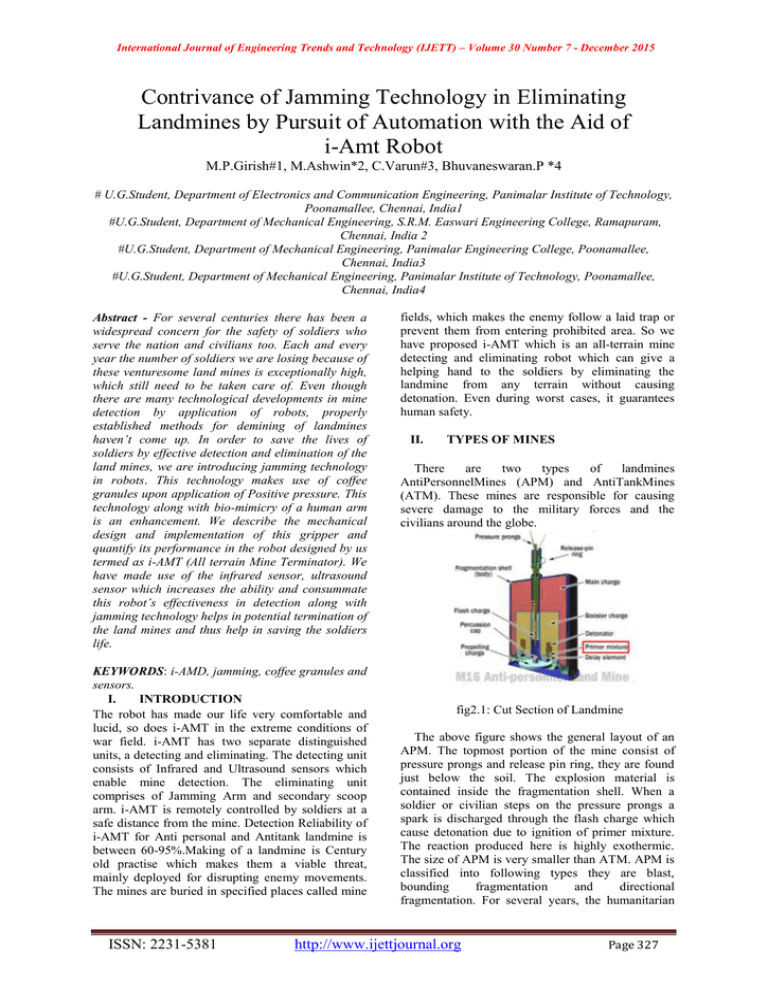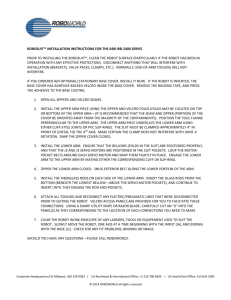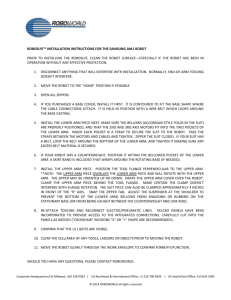Document 12929240
advertisement

International Journal of Engineering Trends and Technology (IJETT) – Volume 30 Number 7 - December 2015 Contrivance of Jamming Technology in Eliminating Landmines by Pursuit of Automation with the Aid of i-Amt Robot M.P.Girish#1, M.Ashwin*2, C.Varun#3, Bhuvaneswaran.P *4 # U.G.Student, Department of Electronics and Communication Engineering, Panimalar Institute of Technology, Poonamallee, Chennai, India1 #U.G.Student, Department of Mechanical Engineering, S.R.M. Easwari Engineering College, Ramapuram, Chennai, India 2 #U.G.Student, Department of Mechanical Engineering, Panimalar Engineering College, Poonamallee, Chennai, India3 #U.G.Student, Department of Mechanical Engineering, Panimalar Institute of Technology, Poonamallee, Chennai, India4 Abstract - For several centuries there has been a widespread concern for the safety of soldiers who serve the nation and civilians too. Each and every year the number of soldiers we are losing because of these venturesome land mines is exceptionally high, which still need to be taken care of. Even though there are many technological developments in mine detection by application of robots, properly established methods for demining of landmines haven’t come up. In order to save the lives of soldiers by effective detection and elimination of the land mines, we are introducing jamming technology in robots. This technology makes use of coffee granules upon application of Positive pressure. This technology along with bio-mimicry of a human arm is an enhancement. We describe the mechanical design and implementation of this gripper and quantify its performance in the robot designed by us termed as i-AMT (All terrain Mine Terminator). We have made use of the infrared sensor, ultrasound sensor which increases the ability and consummate this robot’s effectiveness in detection along with jamming technology helps in potential termination of the land mines and thus help in saving the soldiers life. KEYWORDS: i-AMD, jamming, coffee granules and sensors. I. INTRODUCTION The robot has made our life very comfortable and lucid, so does i-AMT in the extreme conditions of war field. i-AMT has two separate distinguished units, a detecting and eliminating. The detecting unit consists of Infrared and Ultrasound sensors which enable mine detection. The eliminating unit comprises of Jamming Arm and secondary scoop arm. i-AMT is remotely controlled by soldiers at a safe distance from the mine. Detection Reliability of i-AMT for Anti personal and Antitank landmine is between 60-95%.Making of a landmine is Century old practise which makes them a viable threat, mainly deployed for disrupting enemy movements. The mines are buried in specified places called mine ISSN: 2231-5381 fields, which makes the enemy follow a laid trap or prevent them from entering prohibited area. So we have proposed i-AMT which is an all-terrain mine detecting and eliminating robot which can give a helping hand to the soldiers by eliminating the landmine from any terrain without causing detonation. Even during worst cases, it guarantees human safety. II. TYPES OF MINES There are two types of landmines AntiPersonnelMines (APM) and AntiTankMines (ATM). These mines are responsible for causing severe damage to the military forces and the civilians around the globe. fig2.1: Cut Section of Landmine The above figure shows the general layout of an APM. The topmost portion of the mine consist of pressure prongs and release pin ring, they are found just below the soil. The explosion material is contained inside the fragmentation shell. When a soldier or civilian steps on the pressure prongs a spark is discharged through the flash charge which cause detonation due to ignition of primer mixture. The reaction produced here is highly exothermic. The size of APM is very smaller than ATM. APM is classified into following types they are blast, bounding fragmentation and directional fragmentation. For several years, the humanitarian http://www.ijettjournal.org Page 327 International Journal of Engineering Trends and Technology (IJETT) – Volume 30 Number 7 - December 2015 demining work has been constantly obstructed by these blast type mines. The bounding fragmentation is heavier than blast type which can devastate relatively a greater area. III. CONSTRUCTION MANOEUVERING The anti-tank mines are generally designed to destroy the armed vehicles. Compared to antipersonnel mines the explosive charge is much large and the fuse design is such that it can only be triggered by vehicles. The detonating pressure is very high compared to anti-personnel mines. Now a days ATMs are much developed in the sense of the power of explosive, shaped charges and more advanced detonation triggers are being used. fig3.1: All Terrain Wheels fig 2.2 APM MINE Type Dimen sion1 Weight Case Sensiti vity Lethal Range Nation Type1 Weight Size (diameter ) Target Case Material Detonata ble Pressure2 PRBM35 H58m m, D64m m 158g Plastic fig2.3 ATM MINE PMN H56mm, D112mm 600g Rubber 8kg 8kg Belgiu m Former Soviet Union APM Light (100g ~ 4kg) 6~ 15cm Human Plastic 500g ISSN: 2231-5381 VALMA RA-69 H105mm , D130mm MON100 H82mm, D236mm 3.3kg Plastic 10.8kg directly, 6kg through trip wire Radius 27m Italy 5.0kg Steel ATM Heavy (6kg ~ 11kg) 13 ~ 40cm Vehicle Plastic, metal 120kg Depend on fuse Ferritic Stainless steel is used for the manufacturing of chassis because of its ability to withstand large shocks. It is used because of its high density which helps in the stability of the robot. The chassis is supported by a chain linked all terrain four wheel drive to enhance the manoeuvrability. There is enough ground clearance and enclosed within water and dust resistant casing. There is live feed camera to help the controlling soldier get a clear view of the surrounding environment, it is fixed on top just behind the sensors. The camera is available with night vision ( 0.3 megapixels ). It has a radio receiver which is used to control the wheel motors to guide the robot across the terrain. The controlling soldier has the transmitter who gives the command, with the aid of the screen displaying the vicinity of the robot. DETECTION 100m by 9.5m arc Former Soviet Union UXO Various Various None intentional, but can be anything Mostly metal Unpredictable fig3.2: circuit for transmission SW1 SW2 SW3,SW4 SW5,SW6 SW7,SW8 http://www.ijettjournal.org BLOWERMOTOR VACCUM PUMP TURN TABLE (CW & ACW ) JAMMING ARM ( UP,DOWN ) JAMMING ARM ( FRONT,BACK ) Page 328 International Journal of Engineering Trends and Technology (IJETT) – Volume 30 Number 7 - December 2015 SW9,SW10 SECONDARY SCOOP ARM ( UP,DOWN ) SW11,SW12 SECONDARY SCOOP ARM ( FRONT,BACK ) SW13,SW14 SCOOP ( UP,DOWN ) The blowing unit consists of a motor with a fan which is followed by an air guide way which is inclined in a manner such that it faces the ground. The robot is lifted with the help of rack and pinion which is used to incline the robot at required angle for the effective blowing of surrounding soil covering the landmine. fig3.3: circuit for receiving end 1 M1 TURN TABLE 360 DEGREE( CW,ACW ) M2 JAMMING ARM ( UP,DOWN ) M3 JAMMING ARM( FRONT ,BACK) M4 SECONDARY SCOOP ARM ( UP,DOWN ) M5 SECONDARY SCOOP ARM ( FRONT,BACK) M6 SCOOP ( UP,DOWN ) fig3.7: Our demonstration for Universal Gripping Arm fig3.5: circuit for receiving end 2 We have made use of Ultrasound sensors and Infrared sensors which are placed at the front end of the robot, facing the ground. In addition, to ultrasound sensor, Infrared sensors are used to increase the efficiency of detection. This is to confirm the detection of a landmine. This is Two Way detection system. Secondary scoop arm is used in extreme cases where the blowing is not enough to remove the surrounding soil. In extreme conditions like wet environment, snow falls the scooping comes handy. Scoop arm consists of spikes beneath the scoop for loosening the soil and aiding in effective scooping. The scoping arm has the specified degree of freedoms. fig3.8:Three degrees of freedom fig3.6: ultrasound sensor ELIMINATION The elimination consists of a blowing unit, secondary scoop arm and jamming arm ( Universal Gripper arm ). ISSN: 2231-5381 The secondary scoop arm has three degrees of freedom. 1- Up & down 2- Front & back 3- Yaw http://www.ijettjournal.org Page 329 International Journal of Engineering Trends and Technology (IJETT) – Volume 30 Number 7 - December 2015 RANGE 1Km Jamming arm (Universal gripper Arm) is the core of the robot. The jamming arm consists of an elastic membrane (eg. Balloon) which is filled with coffee granules. Coffee is used because of its good binding property under Positive pressure. Positive pressure is created with the help of vacuum motor. When Positive pressure is applied through venturi aspirator these coffee granules interlock with each other hence enable lifting of any object by taking its shape. Since it can lift any object by taking its shape it is referred to as Universal Gripper. The degree of freedom is provided by individual servo motors. These servo motors are connected to a receiver microcontroller which is programmed to receive signals from the receiver microcontroller using an RF module. IV. SPECIFICATION POWER SOURCE -11.1 V, 5200mAh LITHIUM POLYMER BATTERY MICROCONTROLLER TYPE: AT89C51, VOLTAGE 5V,40 PIN, 4 PORT SERVO MOTOR VOLTAGE 6-9V (eliminating system)SPEED 45RPM (6V)- 60RPM (9V) TORQUE 12Kgf-cm (6V) – 30 Kgf-cm (9V) BLOWER MOTOR VOLTAGE 12V,SPEED 20,000RPM, POWER 6 WATTS DC MOTOR VOLTAGE 12V,SPEED 200RPM, TORQUE 50 Kgf-cm VACCUM PUMP VOLTAGE 12V,POWER 6 WATTS SUCTION PRESSURE 120 KPa SUCTION CAPACITY 5L/min RADIO FREQUENCY CONTROLLER 4 CHANNEL,FREQUENCY 2.4GHz VOLTAGE 12V V. WORKING MANOEUVERING The robot is controlled by the soldier. The robot has got a live feeding wireless camera empowered with night vision which gives the soldier a clear picture of the terrains the robot is manoeuvring. The robot has been equipped with all terrain wheel which guides the robot through all harsh environments. The robot is controlled by 2.4 GHz frequency which gives a space of 1 km between the soldier and the robot. DETECTION The robot has been incorporated with ultrasound and infra-red sensors. The Ultrasound sensor sends constant signals of frequency 40 KHz at a rapid rate. When an Ultrasound signal strikes an object the speed of the signal varies and is recorded by the receiver. These recorded values of speed are compared with the known values by the microcontroller. When the speed matches the speed of landmine metal it sends a positive signal. Once a positive signal is obtained from the ultrasound sensor for better efficiency infra-red sensors are used to confirm if a landmine is present. Once both sensors give a positive confirmation the controller gives the command to control the jamming arm and the secondary scooping arm over a radio frequency. Material Steel Lead Water Soft tissues bones ULTRASOUND SENSOR VOLTAGE5V, CURRENT CONSUMPTION 15mA FREQUENCY 40KHz Speed (m/s) 5000 1300 1460 1500 2500 - 4900 ELIMINATION INFRARED SENSOR VOLTAGE5V, CURRENT CONSUMPTION 15mA RANGE 10-80 meter RADIO FREQUENCY MODULE VOLTAGE5V,CURRENT CONSUMPTION 15mA ISSN: 2231-5381 MONITORING SYSTEM NPC MINI WIRELESSCAMERA-0.3 MEGAPIXEL NIGHT VISION Once the mine is located the controller depending on the live feed received decides to switch on the blower motor or not. During the time of blowing the robot is lifted by means of rack and pinion mechanism. The primary function of the blower is to blow away the top soil covering the mine. If the operation of the blower is not enough to separate the landmine from the soil, in that instance secondary scooping arm comes into action which scoops away http://www.ijettjournal.org Page 330 International Journal of Engineering Trends and Technology (IJETT) – Volume 30 Number 7 - December 2015 the surrounding mud in all terrain. Once the landmine is exposed the jamming arm (Universal Gripper Arm) comes into play. By application of Positive pressure, the soldier lifts the landmine from its position and drops it in a safer place. Thus, the landmine is eliminated. VI. DESIGN AND ANALYSIS The figure below shows the proposed jamming arm ( universal gripper arm ) designed using Solidworks 2014 by Dassault systems. fig6.3:Jamming arm analysis Analysis of the secondary scoop arm is done using the same ANSYS R15 by Ansys.Inc fig6.1:Jamming arm This is the proposed model of the secondary scoop arm drawn using the same SolidWorks 2014 by Dassault systems. fig6.4:Secondary scoop arm analysis fig6.2:Secondary scoop arm The total deformation analysis of both the arms is done considering point load. We have considered point load because it is concentrated load and the load applied is at the intersection of the final part hence we get the maximum value of the deformation on the arm. Jamming arm (Universal Gripper arm) is capable of lifting around 15 kg and by applying a point load of 15 kg gives a deformation 0.25 mm maximum. Similarly, in the secondary scoop arm is capable of lifting 500 grams of soil but we have considered a max load of 750 grams and performed the total deformation analysis, the maximum deformation 9.4177 e-5 m. VII. Analysis of the jamming arm (Universal Arm gripper) is done using ANSYS R15 by Ansys.Inc. ISSN: 2231-5381 CONCLUSION One of the major threats to the mankind in war field is landmine which still does not have a stable detection and demining methodology. We have shut off the necessity of demining, by eliminating the landmine with the help of jamming technology. Our proposal demonstrates the minute working and indepth view of jamming technology. Its vast potential has been considered by us and we have effectively http://www.ijettjournal.org Page 331 International Journal of Engineering Trends and Technology (IJETT) – Volume 30 Number 7 - December 2015 made it serve our purpose of eliminating a landmine. Infrared and ultrasound sensors have been used to get a high and mighty detection unit. We perceive that our i-AMT holds key for safe detection and elimination of land mines thereby helping mankind and soldiers to continue their sincere service towards their country and its people. Since the pressure applied over the mine doesn’t exceed 8kg, the detonation doesn’t occur while lifting. Even during worst case scenarios if the mine explodes due to mishandling human safety is guaranteed since the robot takes all the damage. 15. Kanu Priya Sood, Saloni Singla, ―Energy Aware Swarm Intelligence Approach for Route Selection with Multi hopping in Wireless Sensor Network‖ ,International Journal of Engineering Trends and Technology (IJETT) – Volume 26 Number 5- August 2015 16. Vishal Garg , Mukul Jhamb, ―A Review of Wireless Sensor Network on Localization Techniques‖, International Journal of Engineering Trends and Technology (IJETT) Volume4Issue4- April 2013 REFERENCES 1. Bicci and V. Kumar, ―Robotic grasping and contact: A review,‖ in Proc. IEEE Int. Conf. Robot. Autom., Apr., 2000, pp. 348–353. 2. A. M. Dollar and R. D. Howe, ―Simple, robust autonomous grasping in unstructured environments,‖ in Proc. IEEE Int. Conf. Robot. Autom., Apr. 2007, pp. 4693–4700. 3. M. C. Carrozza, C. Suppo, F. Sebastiani, B. Massa, F. Vecchi, R. Lazzarini, M. R. Cutkosky, and P. Dario, ―The SPRING hand: Development of a selfadaptive prosthesis for restoring natural grasping,‖ Auton. Robots, vol. 16, pp. 125–141, Mar. 2004. 4. John R. Amend, Eric Brown,Nicholas Rodenberg, Heinrich M. Jaeger, and Hod Lipson, ―A Positive Pressure Universal Gripper Based on the Jamming of Granular Material‖ IEEE Transactions on Robotics. 5. W. Townsend, ―The BarrettHand grasper—Programmably flexible part handling and assembly,‖ Ind. Robot, vol. 27, pp. 181–188, 2000. 6. D. C. Simpson, ―Gripping surfaces for artificial hands,‖ Hand, vol. 3, pp. 12–14, Feb. 1971. 7. T. Laliberte, L. Birglen, and C. Gosselin, ―Underactuation in robotic grasp- ´ ing hands,‖ Mach. Intell. Robot. Control, vol. 4, pp. 1–11, Sep. 2002. 8. L. Kempen, M. Kaczmarec, H. Sahli, and J. Cornelis, ―Dynamic Infrared Image Sequence Analysis for Anti Personnel Mine Detection,‖ in Proceedings IEEE Benelux Signal Processing Chapter, Signal Processing Symposium, pp. 215-218, Mar. 1998. 9. P. Verlinde, M. Acheroy, and Y. Baudoin. ―The Belgian Humanitarian Demining Project (HUDEM) and the European Research Context,‖ in Proceedings Chiba University Workshop on Humanitarian Demining, Apr. 2001. 10. L. Kempen, A. Katarzin, Y. Pizurion, C. Corneli, and H. Sahli, ―Digital Signal/Image Processing for Mine Detection, Part 2: Ground based Approach,‖ in Proceedings Euro Conference on Sensor Systems and Signal Processing Techniques applied to the Detection of Mines and Unexploded Ordnance, pp. 54-59, Oct. 1999. 11. M. Acheroy, M. Piette, Y. Baudoin, and J. Salmon, ―Belgian Project on Humanitarian Demining (HUDEM) Sensor Design and Signal Processing Aspects,‖ Jul. 2000 12. ―Hidden Killers 1998: The Global Landmine Crisis,‖ US Department of State, Bureau of Political-Military Affairs, Office of Humanitarian Demining Programs, Sep. 1998. 13. C. Bruschini and B. Gros, ―A Survey of Current Sensor Technology Research for the Detection of Landmines,‖ in Proceedings the International Workshop on Sustainable Humanitarian Demining, vol. 6, pp. 18-27, Sep. 1997. 14. Ankit Tiwari, Mohan Gautam, Sanjeev Sharma, Krishan Mura,‖ Automatic Infra-red Sensing System‖, International Journal of Engineering Trends and Technology (IJETT) – Volume 27 Number 5 - September 2015 ISSN: 2231-5381 http://www.ijettjournal.org Page 332






